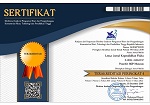Pengaruh Jenis dan Persentase Bahan Perekat Biobriket Berbahan Dasar Kulit Durian terhadap Nilai Kalor dan Laju Pembakaran
DOI:
https://doi.org/10.33394/j-lkf.v10i1.5293Keywords:
Biobriket, Kulit Durian, Perekat, Energi Alternatif, Biobriquette, Durian Peel, Adhesives, Alternative EnergyAbstract
Penelitian ini bertujuan untuk mengetahui pengaruh jenis dan persentase bahan perekat yang digunakan, terhadap nilai kalor dan laju pembakaran biobriket kulit durian. Bahan utama yang digunakan dalam pembuatan biobriket yaitu kulit durian. Bahan perekat yang digunakan adalah tepung tapioka, tepung beras, dan semen dengan persentase masing-masing 10%, 15%, dan 20%. Penelitian ini merupakan penelitian eksperimental dengan kajian literatur yang dilakukan dalam tiga tahap yaitu preparasi bahan, pembuatan biobriket, dan pengujian biobriket. Hasil penelitian menunjukkan nilai kalor biobriket berkisar antara 2509,50 cal – 5771,85 cal dan laju pembakaran berkisar 1,80 gr/menit–2,62 gr/menit. Berdasarkan hasil pengujian diketahui bahwa penambahan bahan perekat menyebabkan laju pembakaran biobriket cenderung meningkat namun nilai kalor cenderung menurun.
Effect of Type and Percentage of Durian Peel-Based Biobriquette Adhesives on Calorific Value and Combustion Rate
Abstract
This study aims to determine the effect of the type and percentage of adhesive used on the heating value and combustion rate of durian peels bio briquettes. The main ingredients used in making bribriquettes are durian peels. The adhesives used are tapioca flour, rice flour, and cement with each percentage of 10%, 15%, and 20%. This research is an experimental study with a literature review conducted in three stages, namely materials preparation, making bio briquettes, and testing briquettes. The results showed that the bio briquettes heating value ranged from 2509.50 cal – 5771.85 cal and the combustion rate 1.80 g/m – 2.62 g/m. Based on the test results that the addition of adhesive caused the combustion rate of the bio briquette to increase but the heating value tended to decrease.
References
Anizar, H., Sribudiani, E., & Somadona, S. (2020). Pengaruh Bahan Perekat Tapioka dan Sagu terhadap Kualitas Briket Arang Kulit Buah Nipah. Perennial, 16(1), 11–17. http://dx.doi.org/10.24259/perennial.v16i1.9159
Ariyanto, E., Karim, M. A., & Firmansyah, A. (2014). Biobriket Enceng Gondok (Eichhornia Crassipes) Sebagai Bahan Bakar Energi Terbarukan. Reaktor, 15(1), 59. https://doi.org/10.14710/reaktor.15.1.59-63
Faizal, M., Andynapratiwi, I., & Putri, P. D. A. (2014). Pengaruh Komposisi Arang dan Perekat terhadap Kualitas Biobriket dari Kayu Karet. Jurnal Teknik Kimia, 20(2), 36–44.
Indah Suryani, M. Yusuf Permana U., M. H. D. (2012). Pembuatan Briket Arang dari Campuran Buah Bintaro dan Tempurung Kelapa Menggunakan Perekat Amilum. Jurnal Teknik Kimia No. 1, Vol. 18, Januari 2012, 18(1), 24–29.
Iriany, Meliza, Firman Abednego S. Sibarani, & Irvan. (2016). Pengaruh Perbandingan Massa Eceng Gondok dan Tempurung Kelapa Serta Kadar Perekat Tapioka terhadap Karakteristik Briket. Jurnal Teknik Kimia USU, 5(1), 20–26. https://doi.org/10.32734/jtk.v5i1.1520
Maryono, Sudding, & Rahmawati. (2013). Pembuatan dan Analisis Mutu Briket Arang Tempurung Kelapa Ditinjau dari Kadar Kanji. Jurnal Chemica, 14(1), 74–83. http://download.portalgaruda.org/article.php?article=150251&val=4338&title=Pembuatan dan Analisis Mutu Briket Arang Tempurung Kelapa Ditinjau dari Kadar Kanji%0Awww.unm.ac.id
Muzi, I., & Mulasari, S. A. (2015). Perbedaan Konsentrasi Perekat Antara Briket Bioarang Tandan Kosong Sawit Dengan Briket Bioarang Tempurung Kelapa Terhadap Waktu Lama Membara. Jurnal Kesehatan Masyarakat, 8(1), 1–10. https://doi.org/10.47317/jkm.v8i1.277
Nasution, Z. A. (2010). Pembuatan dan Karakteristik dari Limbah Jerami Padi untuk Tatakan Gelas Cetak Tangan. Penelitian Pada Balai Riset Stansarisasi Industri Medan, 45(1), 16–21.
Noer, S., Pratiwi, R. D., & Gresinta, E. (2015). Pemanfaatan Kulit Durian sebagai Adsorben Biodegradable Limbah Domestik Cair. Faktor Exacta, 8(1), 75–78. https://journal.lppmunindra.ac.id/index.php/Faktor_Exacta/article/view/304/290
Ramdani, L. M. A., Ahzan, S., & Prasetya, D. S. B. (2020). The Effect of the Type and Composition of the Adhesive on the Physical Properties and the Rate of Combustion Hyacinth Biobriquettes. Lensa: Jurnal Kependidikan Fisika, 8(2), 85. https://doi.org/10.33394/j-lkf.v8i2.2786
Ristianingsih, Y., Ulfa, A., & Syafitri, R. (2015). Karakteristik Briket Bioarang Berbahan Baku Tandan. Jurnal Konversi, 4(2), 16–21.
Smith, H., & Idrus, S. (2017). Pengaruh Penggunaan Perekat Sagu Dan Tapioka Terhadap Karakteristik Briket Dari Biomassa Limbah Penyulingan Minyak Kayu Putih Di Maluku. Majalah BIAM, 13(2), 21. https://doi.org/10.29360/mb.v13i2.3546
Supatata, N., Buates, J., & Hariyanont, P. (2013). Characterization of Fuel Briquettes Made from Sewage Sludge Mixed with Water Hyacinth and Sewage Sludge Mixed with Sedge. International Journal of Environmental Science and Development, 4(2), 179–181. https://doi.org/10.7763/ijesd.2013.v4.330
T, R. (2016). Pemanfaatan Limbah Kulit Durian Sebagai Bahan Baku Briket dan Pestisida Nabati. Biosel: Biology Science and Education, 5(2), 159. https://doi.org/10.33477/bs.v5i2.496
Downloads
Published
How to Cite
Issue
Section
License
Authors who publish with Lensa: Jurnal Kependidikan Fisika agree to the following terms:
- For all articles published in Lensa: Jurnal Kependidikan Fisika, copyright is retained by the authors. Authors give permission to the publisher to announce the work with conditions. When the manuscript is accepted for publication, the authors agree to automatic transfer of the publishing right to the publisher.
- Authors retain copyright and grant the journal right of first publication with the work simultaneously licensed under a Creative Commons Attribution-ShareAlike 4.0 International License that allows others to share the work with an acknowledgment of the work's authorship and initial publication in this journal.
- Authors are able to enter into separate, additional contractual arrangements for the non-exclusive distribution of the journal's published version of the work (e.g., post it to an institutional repository or publish it in a book), with an acknowledgment of its initial publication in this journal.
- Authors are permitted and encouraged to post their work online (e.g., in institutional repositories or on their website) prior to and during the submission process, as it can lead to productive exchanges, as well as earlier and greater citation of published work (See The Effect of Open Access).

This work is licensed under a Creative Commons Attribution-ShareAlike 4.0 International License.



